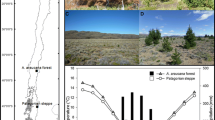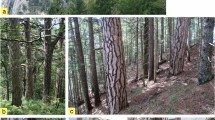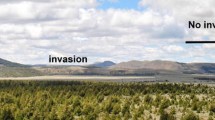Abstract
Despite advances in understanding the ecology and consequences of pine invasions, information on the patterns of structure, dynamics, and growth needed to manage these invasive populations are still poorly known. Here we used tree ring analysis to elucidate growth dynamics, age distribution and fire effects, by sampling three populations of slash pine invading Cerrado vegetation in southeastern Brazil. We found that the invasion occurred in waves, every 5–7 years. These pulses are likely related to the time needed by founder trees to reach maturity, and to climatic events. We found distinct growth patterns among the three study areas. Individual trees in the open sites, under low competition for light, showed an increasing trend of diameter and of the basal area growth rates with age. In the dense stands, however, the diameter increment rates gradually decreased with age, as the competition for light was intensified, and the basal area growth rate increased at lower rates. Growth rates were markedly reduced after fire, likely due to fire impact on the canopies, reducing photosynthesis. Fire scars in the wood allowed us to confirm that the formation of the tree rings occurs annually. When competition for light intensifies as the canopy of the stand closes, the invasive populations experience reduced individual growth of adult trees and constraints to the recruitment of young individuals. We did not find, however, evidence of self-thinning due to competition that could reduce the population of adult trees, open gaps and allow colonization by shade-tolerant native species. Therefore, a monodominant pine stand—the “pine desert” feature of the invaded sites—tends to be persistent over time.








Similar content being viewed by others
References
Abreu RCR (2013) Ecologia e controle da invasão de Pinus elliottii no campo cerrado. São Carlos : Escola de Engenharia de São Carlos, Universidade de São Paulo. Tese de Doutorado em Ciências da Engenharia Ambiental. https://doi.org/10.11606/T.18.2013.tde-23092013-085713
Abreu RCR, Durigan G (2011) Changes in the plant community of a Brazilian grassland savannah after 22 years of invasion by Pinus elliottii Engelm. Plant Ecol Divers 4:269–278. https://doi.org/10.1080/17550874.2011.594101
Almeida RS, Cielo-Filho R, Souza SCPM, Aguiar OT et al (2010) Campo sujo úmido: fisionomia de Cerrado ameaçada pela contaminação de Pinus elliotti Engelm. na Estação Ecológica de Itapeva, Estado de São Paulo. Rev do Inst Florest, pp 71–91
Bechara FC, Reis A, Bourscheid K et al (2013) Reproductive biology and early establishment of Pinus elliottii var. elliottii in Brazilian sandy coastal plain vegetation: implications for biological invasion. Sci Agric 70:88–92. https://doi.org/10.1590/S0103-90162013000200005
Bigler C (2016) Trade-offs between growth rate, tree size and lifespan of mountain pine (Pinus montana) in the swiss national park. PLoS ONE 11:1–18. https://doi.org/10.1371/journal.pone.0150402
Biondi F (1999) Comparing tree-ring chronologies and repeated timber inventories as forest monitoring tools. Ecol Appl 9:216–227
Biondi F (2001) A 400-year tree-ring chronology from the tropical treeline of North America. Ambio 30:162–166
Bourscheid K, Reis A (2011) Dinâmica da invasão de Pinus elliottii Engelm. em restinga sob processo de restauração ambiental no Parque Florestal do Rio Vermelho, Florianópolis, SC. Biotemas 23:23–30. https://doi.org/10.5007/2175-7925.2010v23n2p23
Brandes AFN, Sánchez-Tapia A, Sansevero JBB et al (2018) Fire records in tree rings of Moquiniastrum polymorphum: potential for reconstructing fire history in the Brazilian Atlantic Forest. Acta Bot Bras. https://doi.org/10.1590/0102-33062018abb0282
Brando PM, Durigan G (2004) Changes in cerrado vegetation after disturbance by frost (São Paulo State, Brazil). Plant Ecol 175:205–215
Brewer JS, Souza FM, Callaway RM, Durigan G (2018) Impact of invasive slash pine (Pinus elliottii) on groundcover vegetation at home and abroad. Biol Invasions 20:2807–2820. https://doi.org/10.1007/s10530-018-1734-z
Brienen RJW, Zuidema PA (2006) The use of tree rings in tropical forest management: projecting timber yields of four Bolivian tree species. For Ecol Manage 226:256–267. https://doi.org/10.1016/j.foreco.2006.01.038
Brito JO, Ferraz ESB, Barrichelo LEC, do Couto HTZ (1986) A adubação mineral e seus efeitos sobre os anéis de crescimento da madeira de Pinus caribaea var. bahamensis. IPEF 32:5–17
Buckley BM, Duangsathaporn K, Palakit K et al (2007) Analyses of growth rings of Pinus merkusii from Lao P.D.R. For Ecol Manage 253:120–127. https://doi.org/10.1016/j.foreco.2007.07.018
Carey JH (1992) Pinus elliottii. In: Fire effects information system (Online). U.S. Department of Agriculture, Forest Service, Rocky Mountain Research Station, Fire Sciences Laboratory (Producer). https://www.fs.fed.us/database/feis/plants/tree/pinell/all.html. Accessed on 21 Aug 2019
Coelho VCM, Hosokawa RT (2010) Avaliação da reação de crescimento aos desbastes em Pinus taeda L. Rev Agro@ mbiente 4:42–48
Colautti RI, MacIsaac HJ (2004) A neutral terminology to define “invasive” species. Divers Distrib 10:135–141. https://doi.org/10.1111/j.1366-9516.2004.00061.x
Cook ER (1985) Time series analysis approach to tree ring standardization. Dissertation, University of Arizona
Couralet C, Sassklaassen U, Sterck F et al (2005) Combining dendrochronology and matrix modelling in demographic studies: an evaluation for in Ethiopia. For Ecol Manag 216:317–330. https://doi.org/10.1016/j.foreco.2005.05.065
D’Arrigo R, Watanasak M, Boonchirdchoo S et al (1997) Progress in dendroclimatic studies of Mountain Pine in Northern Thailand. IAWA J 18:433–444. https://doi.org/10.1163/22941932-90001508
Diez JM, D’Antonio CM, Dukes JS et al (2012) Will extreme climatic events facilitate biological invasions? Front Ecol Environ 10:249–257. https://doi.org/10.1890/110137
Elesbão L, Schneider P (2011) Produção do Pinus taeda L. em povoamento desbastado na região dos campos de cima da serra. Rio Grande do Sul. Ciência Florest 21:119–124
Ferreira ATB, Filho MT (2009) Caracterização dos anéis de crescimento de árvores de Pinus caribaea var. hondurensis Barr. et Golf. por densitometria de raios X. Sci For 37:287–298
Figueiredo Filho A, do Machado SA, Figueiredo DJ DJ, Kikuti P (1994) Comparação do crescimento em diâmetro, altura e volume entre árvores resinadas e não resinadas de Pinus elliottii Engelm. var elliottii. Floresta 22:13–24
Fischer FM, Oliveira JM, Dresseno ALP, Pillar VD (2014) The role of invasive pine on changes of plant composition and functional traits in a coastal dune ecosystem. Nat Conserv 12:19–23. https://doi.org/10.4322/natcon.2014.004
Fritts HC (1976) Tree rings and climate. Academic Press, London
Harley G, Grissino-Mayer H, Horn S (2011) The dendrochronology of Pinus elliottii in the lower Florida Keys: chronology development and climate response. Tree Ring Res 67:39–50
Hoffmann WA, Flake SW, Abreu RCR et al (2019) Rare frost events reinforce tropical savanna–forest boundaries. J Ecol 107:468–477. https://doi.org/10.1111/1365-2745.13047
INMET (2018) BDMEP—Banco de Dados Meteorológicos para Ensino e Pesquisa. In: Instituto Nacional de Meteorologia
Inoue MT, Filho AF, Lima R (2011) Influence of vital growth space on height and diameter of Pinus taeda L. Sci For 39:377–385
Johnson WC (1980) Dendrochronological sampling of Pinus oocarpa Shiede near Copan, Honduras: a preliminary note. Biotropica 12:315. https://doi.org/10.2307/2387704
Klink CA, Machado RB (2005) A conservação do Cerrado brasileiro. Megadiversidade 1:147–155
Kronka FJN, Bertolani F, Ponce RH (2005) A cultura do pinus no Brasil. Sociedade Brasileira de Silvicultura, São Paulo
Langdon B, Pauchard A, Aguayo M (2010) Pinus contorta invasion in the Chilean Patagonia: local patterns in a global context. Biol Invasions 12:3961–3971. https://doi.org/10.1007/s10530-010-9817-5
Lawes MJ, Adie H, Russell-Smith J et al (2011) How do small savanna trees avoid stem mortality by fire? The roles of stem diameter, height and bark thickness. Ecosphere. https://doi.org/10.1890/es10-00204.1
Locosssselli GM, Krottenthaler S, Pitsch P et al (2017) Age and growth rate of congeneric tree species (Hymenaea Spp.—Leguminosae) inhabiting different tropical biomes. Erdkunde 71:45–57. https://doi.org/10.3112/erdkunde.2017.01.03
Melo ACG, Durigan G (2009) Plano de Manejo da Estação Ecológica de Santa Bárbara. Águas de Santa. Instituto Florestal/SEMA, São Paulo, 222 pp
Miashike RL (2015) Invasão por Pinus spp. em fisionomias campestres do Cerrado, no estado de São Paulo. Universidade de São Paulo
Miranda HS, Sato MN, Neto WN, Aires FS (2009) Fires in the cerrado, the Brazilian savanna. In: Tropical fire ecology, Springer, Berlin, pp 427–450
Moya R, Filho MT (2009) Wood density variation and tree ring demarcation in Gmelina arborea trees using X-ray densitometry. Cerne 15:92–100
Murphy BP, Russell-Smith J, Prior LD (2010) Frequent fires reduce tree growth in northern Australian savannas: implications for tree demography and carbon sequestration. Glob Chang Biol 16:331–343. https://doi.org/10.1111/j.1365-2486.2009.01933.x
Nuñez MA, Chiuffo MC, Torres A et al (2017) Ecology and management of invasive Pinaceae around the world: progress and challenges. Biol Invasions 19:3099–3120. https://doi.org/10.1007/s10530-017-1483-4
Oliveira-Filho A, Ratter J (2002) Vegetation Physiognomies and Woody Flora of the Cerrado Biome. In: Oliveira PS, Marquis RJ (eds) The cerrados of Brazil: ecology and natural history of a neotropical savanna. Columbia University Press, New York, pp 91–120
Ortega Rodriguez DR, de Andrade GC, Bellote AFJ, Tomazello-Filho M (2018) Effect of pulp and paper mill sludge on the development of 17-year-old loblolly pine (Pinus taeda L.) trees in Southern Brazil. For Ecol Manag 422:179–189. https://doi.org/10.1016/j.foreco.2018.04.016
Palermo GPM, Latorraca JVF, de Rezende MA et al (2003) Análise da densidade da madeira de Pinus elliottii Engelm por meio de radiação gama de acordo com as direções estruturais (longitudinal e radial) e a idade de crescimento. Floresta e Ambient 10:47–57
Palermo GP, Latorraca JVF, Severo ETD et al (2013) Delimitation the juvenile and mature wood of Pinus elliottii Engelm. Rev Árvore 37:191–200
Pauchard A, Escudero A, García RA et al (2016) Pine invasions in treeless environments: dispersal overruns microsite heterogeneity. Ecol Evol 6:447–459. https://doi.org/10.1002/ece3.1877
Pereira J, Ahrens S (2003) Efeito da Desrama sobre a Espessura ea Densidade da Madeira dos Anéis de Crescimento de Pinus taeda L. Bol Pesq Fl, Colombo 46:47–56
Pereira JCD, Tomaselli I (2004) A Influência do Desbaste na Qualidade da Madeira de Pinus elliottii Engelm. var. elliottii. Bol Pesq Fl 49:61–81
Pyke DA, Brooks ML, D’Antonio C (2010) Fire as a restoration tool: a decision framework for predicting the control or enhancement of plants using fire. Restor Ecol 18:274–284. https://doi.org/10.1111/j.1526-100X.2010.00658.x
Richardson DM (2006) Pinus: a model group for unlocking the secrets of alien plant invasions? Preslia 78:375–388
Richardson DM, Higgins SI (1998) Pines as invaders in the southern hemisphere. In: Richardson DM (ed) Ecology and biogeography of Pinus. Cambridge University Press, Cambridge, pp 450–473
Richardson DM, Rejmánek M (2004) Conifers as invasive aliens: a global survey and predictive framework. Divers Distrib 10:321–331. https://doi.org/10.1111/j.1366-9516.2004.00096.x
Richardson DM, Williams PA, Hobbs RJ (1994) Pine invasions in the southern hemisphere: determinants of spread and invadability. J Biogeogr 21:511–527. https://doi.org/10.2307/2845655
Rozendaal DMA, Zuidema PA (2011) Dendroecology in the tropics: a review. Trees 25:3–16. https://doi.org/10.1007/s00468-010-0480-3
Sah JP, Ross MS, Snyder JR, Ogurcak DE (2010) Tree mortality following prescribed fire and a storm surge event in slash pine (Pinus elliottii var. densa) forests in the Florida Keys, USA. Int J For Res 2010:1–13. https://doi.org/10.1155/2010/204795
Sarutanon S, Boonchirdchoo S, Arrigo RD et al (1995) Dendrochronological investigations in Thailand. IAWA J 16:393–409. https://doi.org/10.1163/22941932-90001429
Schneider PR, Elesbão LEG, Schneider PSP, Longhi RV (2013) Crescimento em altura dominante do Pinus elliottii e Pinus taeda em solos arenizados degradados no oeste do Rio Grande do Sul. Ciência Rural 43:1981–1986
Schöngart J (2008) Growth-Oriented Logging (GOL): a new concept towards sustainable forest management in Central Amazonian varzea floodplains. For Ecol Manag 256:46–58. https://doi.org/10.1016/j.foreco.2008.03.037
Schulman E (1944) Dendrochronology in Mexico. Tree-ring Bull 10:18–24
Schulman E (1956) Dendroclimatic changes in semiarid America. University of Arizona Press, Tucson
Seifert T, Meincken M, Odhiambo BO (2017) The effect of surface fire on tree ring growth of Pinus radiata trees. Ann For Sci 74:34. https://doi.org/10.1007/s13595-016-0608-8
Sigal PS (2011) Tropical dendrochronology: exploring tree-rings of Pinus oocarpa in eastern Guatemala. Georg-August-Universität Göttingen
Silva CEF, Reis CM, Zanchetta D et al (2006) Plano de Manejo Integrado. Estações Ecológica e Experimental de Itirapina/SP. Itirapina
Simberloff D (2014) Biological invasions: What’s worth fighting and what can be won? Ecol Eng 65:112–121
Simberloff D, Rejmánek M (2011) Encyclopedia of biological invasions. University of California Press, Berkley
Simberloff D, Nuñez MA, Ledgard NJ et al (2009) Spread and impact of introduced conifers in South America: lessons from other southern hemisphere regions. Aust Ecol 35:489–504. https://doi.org/10.1111/j.1442-9993.2009.02058.x
Sociedade Brasileira de Silvicultura (2008) Fatos e Números do Brasil Florestal. Sociedade Brasileira de Silvicultura, São Paulo
Speer JH (2010) Fundamentals of tree-ring research. The University of Arizona Press, Arizona
Speer JH, Orvis KH, Grissino-Mayer HD et al (2004) Assessing the dendrochronological potential of Pinus occidentalis Swartz in the Cordillera Central of the Dominican Republic. Holocene 14:563–569. https://doi.org/10.1191/0959683604hl732rp
Stahle D, Mushove P, Cleaveland M (1999) Management implications of annual growth rings in Pterocarpus angolensis from Zimbabwe. For Ecol Manage 124:217–229
Taylor AH, Skinner CN (2003) Spatial patterns and controls on historical fire regimes and forest structure in the Klamath Mountains. Ecol Appl 13:704–719. https://doi.org/10.1890/1051-0761(2003)013%5b0704:spacoh%5d2.0.co;2
Tomazello-Filho M, Latorraca JVF, Fischer FM et al (2017) Avaliação da dispersão de sementes de Pinus taeda L. pela análise dos anéis de crescimento de árvores de regeneração Natural. Floresta e Ambient. https://doi.org/10.1590/2179-8087.040913
Trovati LR, Ferraz ESB (1984) Influência da precipitação e da temperatura na densidade dos anéis de crescimento de Pinus oocarpa. IPEF 26:31–36
Vasquez AG, Nogueira AS, Kirchner FF, Berger R (2007) Uma síntese da contribuição do Gênero Pinus para o desenvolvimento sustentável no sul do Brasil. Floresta 37:445–450
Venegas-González A, Chagas MP, Anholetto Júnior CR et al (2015) Sensitivity of tree ring growth to local and large-scale climate variability in a region of Southeastern Brazil. Theor Appl Climatol. https://doi.org/10.1007/s00704-014-1351-4
Vlam M, van der Sleen P, Groenendijk P, Zuidema PA (2017) Tree age distributions reveal large-scale disturbance-recovery cycles in three tropical forests. Front Plant Sci 7:1–12. https://doi.org/10.3389/fpls.2016.01984
Weiner J, Thomas SC (2001) The nature of tree growth and the“age-related decline in forest productivity”. Oikos 94:374–376
Worbes M (1995) How to measure growth dynamics in tropical trees: a review. Iawa J 16:337–351
Worbes M (1999) Annual growth rings, rainfall dependent growth and long-term growth patterns of tropical trees from the Caparo Forest Reserve in Venezuela. J Ecol 87:391–403
Worbes M, Staschel R, Roloff A, Junk W (2003) Tree ring analysis reveals age structure, dynamics and wood production of a natural forest stand in Cameroon. For Ecol Manag 173:105–123
Zanchetta D, Diniz FV (2006) Estudo da contaminação biológica por Pinus spp. em três diferentes áreas na estação ecológica de Itirapina (SP, Brasil). Rev Inst Flor 18:1–14
Zanchetta D, Pinheiro LS (2007) Análise biofísica dos processos envolvidos na invasão biológica de sementes de Pinus elliottii na Estação Ecológica de Itirapina—SP e alternativas de. Climatol Estud Paisag 2:72. http://cecemca.rc.unesp.br/ojs/index.php/climatologia/article/view/230/643
Zenni RD, Simberloff D (2013) Number of source populations as a potential driver of pine invasions in Brazil. Biol Invasions 15:1623–1639. https://doi.org/10.1007/s10530-012-0397-4
Zimmer H, Baker P (2009) Climate and historical stand dynamics in the tropical pine forests of northern Thailand. For Ecol Manag 257:190–198. https://doi.org/10.1016/j.foreco.2008.08.027
Zuidema PA, Vlam M, Chien PD (2011) Ages and long-term growth patterns of four threatened Vietnamese tree species. Trees 25:29–38. https://doi.org/10.1007/s00468-010-0473-2
Acknowledgments
We thank the staff of SBEcS and the staff of IEcS for logistical support. GD and RCRA thank the National Council for Scientific and Technological Development (CNPq) for research grants to GD (#561771/2010 and #312292/2016-3) and Ph.D. grant for RCRA. RCRA also thanks CAPES/FULBRIGHT for a research grant. GAFD thanks PIBIC/UFF for a research grant. Research permit# 260108—013.650/2009 (SMA-SP/IF). The authors thank to Sam Flake for the language review and one anonymous reviewer for the suggestions that helped to improve the MS.
Author information
Authors and Affiliations
Corresponding author
Additional information
Publisher's Note
Springer Nature remains neutral with regard to jurisdictional claims in published maps and institutional affiliations.
Rights and permissions
About this article
Cite this article
Brandes, A.F.N., Albuquerque, R.P., Domingues, G.A.F. et al. Dendroecology of Pinus elliottii Engelm. reveals waves of invasion in a neotropical savanna. Biol Invasions 22, 403–419 (2020). https://doi.org/10.1007/s10530-019-02099-2
Received:
Accepted:
Published:
Issue Date:
DOI: https://doi.org/10.1007/s10530-019-02099-2




